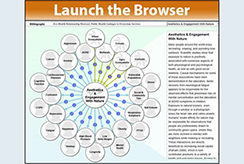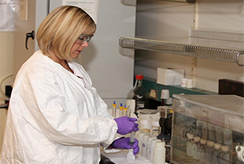Milestones in EPA's Healthy Communities Research History
Since it's founding in 1970, EPA has been working for a cleaner, healthier environment for the American people. Every step has been grounded in science. EPA researchers work to identify and quantify aspects of the natural (ecosystems) and human-dominated (built) environments and how they underpin community health, prosperity, and resiliency.
See also:
History of EPA Research
EPA at 50: Progress for a Stronger Future
1997 - EPA Helps Establish NIEHS/EPA Children's Centers
 EPA and National Institute of Environmental Health Sciences (NIEHS) establish Children's Environmental Health and Disease Prevention Research Centers (Children's Centers). The Children's Centers have produced knowledge vital to demonstrating and halting the health effects of low-level lead exposure to children.
EPA and National Institute of Environmental Health Sciences (NIEHS) establish Children's Environmental Health and Disease Prevention Research Centers (Children's Centers). The Children's Centers have produced knowledge vital to demonstrating and halting the health effects of low-level lead exposure to children.
NIEHS/EPA Children's Environmental Health and Disease Prevention Research Centers
2003 - EPA Begins Work on the Report on the Environment
 EPA began a bold initiative to assemble, for the first time, the most reliable available indicators of national environmental and health conditions and trends that are important to EPA’s mission. The Agency released the Report on the Environment and a companion report in 2008. EPA continues to update the report that provides the best available indicators of national trends in the status and condition of the U.S. environment and human exposure and health.
EPA began a bold initiative to assemble, for the first time, the most reliable available indicators of national environmental and health conditions and trends that are important to EPA’s mission. The Agency released the Report on the Environment and a companion report in 2008. EPA continues to update the report that provides the best available indicators of national trends in the status and condition of the U.S. environment and human exposure and health.
EPA's Report on the Environment (ROE)
2012 - EPA Releases the Eco-Health Relationship Browser
 EPA releases the Eco-Health Relationship Browser to help communities and others better account for and protect the benefits they derive from natural ecosystems. The browser is designed to increase understanding of the nation’s ecosystems, the services they provide, and how those services benefit public health and well-being.
EPA releases the Eco-Health Relationship Browser to help communities and others better account for and protect the benefits they derive from natural ecosystems. The browser is designed to increase understanding of the nation’s ecosystems, the services they provide, and how those services benefit public health and well-being.
EnviroAtlas Eco-Health Relationship Browser
2017 - EPA's “Virtual Stomach” Method Guides Soil Cleanup
 EPA validates a method to guide cleanup of soils contaminated with lead and arsenic. The "virtual stomach" method mimics how the human body absorbs the contaminants and saves millions of dollars in cleanup costs.
EPA validates a method to guide cleanup of soils contaminated with lead and arsenic. The "virtual stomach" method mimics how the human body absorbs the contaminants and saves millions of dollars in cleanup costs.
New Testing Method for Lead and Arsenic in Contaminated Soil Saves Money and Protects Public Health
2018 - EPA and Federal Partners Develop the Lead Action Plan
 EPA and partners with Housing and Urban Development and Health and Human Services to develop the Federal Lead Action Plan. The Plan a blueprint for reducing lead exposure. Under this plan, EPA researchers are working to understand the drivers of blood lead levels and inform regulatory decisions.
EPA and partners with Housing and Urban Development and Health and Human Services to develop the Federal Lead Action Plan. The Plan a blueprint for reducing lead exposure. Under this plan, EPA researchers are working to understand the drivers of blood lead levels and inform regulatory decisions.
Federal Action Plan to Reduce Childhood Lead Exposure
2020 - EPA and Federal Partners Study Ways to Reduce the Risk of Exposure to COVID
 EPA researchers and partners at Centers for Disease Control and Prevention are building on an expansive body of world-class research and applying that knowledge to reduce the risk of exposure to SARS--CoV-2, the virus that causes COVID-19.
EPA researchers and partners at Centers for Disease Control and Prevention are building on an expansive body of world-class research and applying that knowledge to reduce the risk of exposure to SARS--CoV-2, the virus that causes COVID-19.
